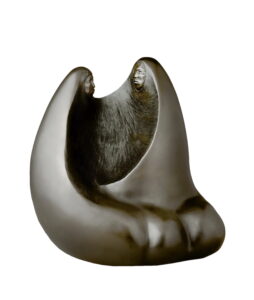
Allan Houser (Fort Sill Apache), Camp Talk, 1979, bronze, H. 23 1/2 × W. 22 1/2 × D. 21 1/2 in., Courtesy of Allan Houser Inc.; © Chiinde LLC
Photo Credit: Wendy McEahern
RALEIGH, NC – A profoundly effective and much anticipated exhibition in our state, To Take Shape and Meaning: Form and Design in Contemporary American Indian Art at the North Carolina Museum of Art in Raleigh, North Carolina amplifies imperative perspectives on and expressions of Indigenous pasts, presents, and futures. Artwork created by 75 Indigenous artists from over 50 tribes throughout the United States and Canada – including eight from North Carolina – is arranged into five themes of encoded commentary, place of being, rootedness, genealogy, and revival and evolution. Nancy Strickland Fields (Lumbee), Director and Curator at the Museum of the Southeastern American Indian at the University of North Carolina at Pembroke and guest curator of To Take Shape and Meaning, has organized an exceptional, experiential exhibition that is simultaneously celebratory and deferent.
Exclusively in three dimensions, included artwork impressively spans the array of artistic mediums. I was drawn to intricately crafted jewelry, notably Kenneth Johnson‘s (Muscogee/Seminole) Sun Spider Cuff (2023); precise beadwork; and woven baskets such as Wedding Basket (1979) by Sally Black (Diné/Navajo) that emphasize the extensive expertise and intensive processes inherent in Indigenous art. This exhibition’s contemporary examples of traditional artistic practices today are evidence of Indigenous survival despite historic forcible removal and “assimilation” efforts in the name of colonization.
Expanding beyond this message of survival, the artwork on display, accompanying didactic text panels, and direct voices of exhibiting artists in wall labels and through explanatory videos on interactive video screens all work in unison to upend one’s understanding of the boundaries of artistic traditions and the stereotypes associated with Native American art. Commanding large-scale sculpture such as Raven Halfmoon‘s (Caddo Nation) Soku & Nish (Sun & Moon – Caddo) (2022); fashion and couture pieces including Jamie Okuma‘s (Luiseno/Shoshone-Bannock/Wailaki/Okinawan) reimagined Louboutin heels in Adaptation II (2012); and cars (yes, there are two!) all integrate traditional Indigenous techniques, imagery, or materials into their unique, innovative artwork. Halfmoon’s sculpture demands attention; the larger-than-life glazed ceramic woman is split down the middle between by colors of black and grayish white that do not reach the floor, leaving a natural clay color at the base. Evolved from Caddo pottery traditions, textured evidence of Halfmoon’s hand is immediately visible and, in her words included in the wall label, her sculptures announce “We are still here and we are powerful.” I was pleased to find that as I made my way through the five thematic sections of To Take Shape and Meaning, this directive was evident everywhere and solidified Indigenous art not as an endangered practice with fixed, homogenous traditions (which unfortunately has historically been the promoted perspective), but as a thriving force of evolving ideas and diverse applications.
Most poignant and exemplary of this exhibition’s success in reclaiming the authority over Indigenous art and storytelling is Dallin Maybee‘s (Northern Arapaho/Seneca) My Story (2021), a collage of events across time on smoked buckskin backed with buffalo hide. The circular construction profiles a powwow scene at the highest point and painted elements including teepees, tents, Arapaho symbols, and an astronaut and spacecraft above earth cover the remaining surface. My Story reminds me of a story quilt where a narrative is pieced together in quilt form (see Faith Ringgold‘s 90s story quilts and Stephen Towns‘ Nat Turner story quilts), but as it was described as a map on the wall label and included in the “Encoded Commentary” thematic gallery, my reflection is this: maps – like narratives, and even like exhibitions – are stories crafted by individuals who choose what to include and what to leave out, and sometimes force out.
Maria (2014) by Rose B. Simpson (Santa Clara Pueblo), one of several Indigenous artists exhibiting in the 2024 Whitney Biennial Even Better Than the Real Thing, is an inventive application of Indigenous artistic traditions hailed as an iconic example of contemporary Native American art in the U.S. It is a significant inclusion in this exhibition.

Rose B. Simpson (Santa Clara Pueblo), Maria, 2014, 1985 Chevy El Camino, H. 54 × W. 72 × D. 202 in., Courtesy of the artist
Restored by Simpson and perceived by her as a vessel, the 1985 El Camino’s sleek black-on-black design is patterned to represent the valley in Española, New Mexico and pays homage to renowned 20th century potter Maria Martinez (San Ildefonso Pueblo) whose Bowl (circa 1942-43) created with her husband Julian Martinez is also exhibited. A short video of Simpson discussing and driving Maria from the Minneapolis Institute of Art accompanies the car to powerfully convey in her words how in lowriding, “cars build identity and create empowerment in disenfranchised peoples.”
To Take Shape and Meaning highlights the generational nature of Indigenous art and knowledge, showcasing work by related artists, including Making Babies for Indian Market (2004) by Simpson’s mother, Roxanne Swentzell (Santa Clara Pueblo). Basketmakers Kelly Church (Ottawa/Potawatomi/Matchi-be-nash-she-wish) and daughter Cherish Parrish (Ottawa/Potawatomi/Matchi-be-nash-she-wish) both protect their generational practice. Church’s blueberry time (2015) basket embodies generations of black ash basket weaving through decorative curlicue overlay, black ash splint, and sweetgrass that, with a bit of Rit dye, charmingly resembles a blueberry. Also woven with black ash and sweetgrass, Parrish’s The Next Generation – Carriers of Culture (2018), a beautifully executed basket shaped to the curves of a pregnant mother’s torso, exemplifies how cultural knowledge is passed down through generation and, much like Simpson, considers the limits of the term “vessel.”
To catch the familial ties, skillful infusions of critical questioning, and crucial underlying connotations enclosed by each artist within their artwork, To Take Shape and Meaning requires a thoughtful, diligent, and reflective visit. I applaud the way in which the deep-seated theme of confronting injustice and changing narratives through continued practice of traditional arts foundationally connects all 75 artists while each is allotted the space to individually shine brightly. However, because I was so impressed with the scope and the impact of this exhibition and because increased visibility of Indigenous perspectives in society is of paramount importance, I wish that more direction was provided to visitors on where to start with this concept and how to continue education afterwards. Having studied essential Indigenous scholars’ and artists’ work in university coursework, I approached this experience equipped with an education and perspective that situates this exhibition in an interdisciplinary history. What about visitors who are encountering Indigenous art and decolonial theory and practice for the first time? How should they approach this exhibition and how should they reflect on it?

Jeremy Frey (Passamaquoddy), Quilted Cedar, 2020, black ash, cedar bark, sweet grass, and synthetic dye, H. 19 × W. 10 × D. 4 in., The Robert and Barbara Buker Collections
In this way, to visitors, I implore you to look closely at the details and then zoom your perspective out to refocus on the larger picture. Notice the braided sweetgrass woven through the lid of the phenomenal oblong Multi-Top Point Basket (2020) crafted by Jeremy Frey (Passamaquoddy). Attempt to read the U.S. images and historical documents containing information about Osage people and shaped into Osage symbols as they float above a wedding coat in Anita Fields’ (Osage Nation and Muscogee Creek Nation) To Know Your People Are Beautiful (2019). Engage with the sporadic interactive video screens to hear from exhibiting artists about how they usher their work to take shape through traditional methods and materials and how they embed spirit and meaning within each piece. To Take Shape and Meaning is an experiential museum, amplifying a narrative that is absolutely vital in North Carolina and throughout our country in a way that showcases the power and potential of Indigenous art.
To Take Shape and Meaning: Form and Design in Contemporary American Indian Art is on view at the North Carolina Museum of Art in the East Building through July 28. Entry is free for NCMA members, college students, and those under 18; tickets begin at $20 for adults and $17 for visitors age 65 and older. For more details on this exhibition and to purchase tickets, visit the NCMA’s website.










